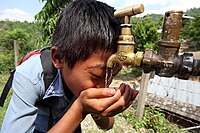
Photo from wikipedia
Assessment of groundwater conditions particularly its potential for sustainable groundwater management is a major concern for agriculture, domestic, and industrial water security. The rapid growth in population and urbanization impose… Click to show full abstract
Assessment of groundwater conditions particularly its potential for sustainable groundwater management is a major concern for agriculture, domestic, and industrial water security. The rapid growth in population and urbanization impose to the high demand of water for drinking as well as for irrigation propose in quaternary aquifers in Ganga Plains and over-exploitation of groundwater resources for drinking and irrigation purpose causes a high rate of water level depletion in Ganga plains. The aim of the present work to develop the integrated groundwater recharges potential using geographical information system (GIS) and analytic hierarchy process (AHP) techniques. The important biophysical and hydrogeological factors influencing the groundwater recharge considered are hydrogeomorphology, geology, LULC, depth to water level, rainfall, soil texture, NDVI, and slope. Thereafter, all the parameters were integrated into a GIS environment for developing the groundwater recharge suitability assessment. Multicriteria decision-making model used to develop the groundwater recharge suitability maps and classified into four zones with varying spatial coverage from very high (15%), high (63%), moderate (20%), and poor (2%). The groundwater recharge suitability zones were also validated with actual bore well yield data of the study area for each recharge suitability zones. Results of integrated geoinformatics and spatial decision-making techniques are a very useful scientific tool for groundwater recharge assessment of Indo-Gangetic Plains for assessment of suitable recharge techniques and locations for future groundwater sustainability and action plan.
Journal Title: Arabian Journal of Geosciences
Year Published: 2020
Link to full text (if available)
Share on Social Media: Sign Up to like & get
recommendations!